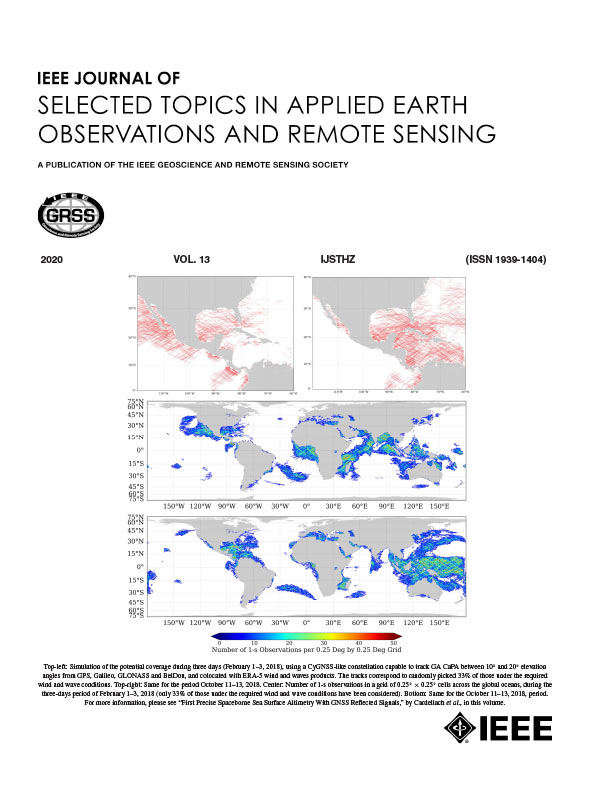Multisensor Glacier Surface Classification Using Confidence-Aware Explainable Inverse-Mapping Neural Network
IF 4.7
2区 地球科学
Q1 ENGINEERING, ELECTRICAL & ELECTRONIC
IEEE Journal of Selected Topics in Applied Earth Observations and Remote Sensing
Pub Date : 2024-09-05
DOI:10.1109/JSTARS.2024.3454789
引用次数: 0
Abstract
Mapping snow cover at the end of the ablation season allows us to extract the snow line altitude (SLA). The SLA is an important proxy for the equilibrium line altitude of a glacier and an indicator of glacier health. With the increase in both active and passive remote sensing satellites, the accuracy and effectiveness of glacier monitoring can be enhanced, as the two sensors offer complementary information. In this article, we focus on the combination of Sentinel-1 synthetic aperture radar (SAR) and Sentinel-2 optical data to perform glacial classification using an explainable neural network and thereafter determine SLA. In addition, confidence-aware inverse mapping dynamics is used to understand the result reliability and the individual sensor contributions. The proposed method is applied to the Great Aletsch Glacier in the European Alps, where an overall accuracy of 83% is observed compared to the ground truth data. We observe the glacier from 2015 to 2023, noting a retreat of the SLA to higher elevations by 36 to 133 m depending on the region. Apart from climate-related mass loss, the European Alps are also affected by dust deposited during Sahara dust events and contamination from algae. Thus, in this work, we assess the annual presence of contaminated snow on the glacier. The inverse mapping dynamics reveals the contributions of both SAR and optical sensor data in the classification. This multisensor approach is shown to mitigate the limitations of single-source data, providing a comprehensive understanding of glacier dynamics in the context of climate change.利用可信度感知的可解释反映射神经网络进行多传感器冰川表面分类
绘制消融季节末期的积雪覆盖图可以提取雪线高度(SLA)。雪线海拔高度是冰川平衡线海拔高度的重要代表,也是冰川健康状况的指标。随着主动和被动遥感卫星的增加,冰川监测的准确性和有效性可以得到提高,因为这两种传感器可以提供互补信息。在本文中,我们将重点研究如何结合哨兵-1 号合成孔径雷达(SAR)和哨兵-2 号光学数据,利用可解释神经网络进行冰川分类,进而确定 SLA。此外,还使用了置信度感知反映射动力学来了解结果的可靠性和单个传感器的贡献。所提出的方法被应用于欧洲阿尔卑斯山的大阿莱奇冰川,与地面实况数据相比,总体准确率达到 83%。我们对 2015 年至 2023 年的冰川进行了观测,发现根据地区不同,SLA 向高海拔地区后退了 36 至 133 米。除了与气候有关的质量损失,欧洲阿尔卑斯山还受到撒哈拉沙尘暴期间沉积的沙尘和藻类污染的影响。因此,在这项工作中,我们对冰川上每年出现的污染雪进行了评估。反绘图动力学揭示了合成孔径雷达和光学传感器数据在分类中的贡献。这种多传感器方法可以缓解单一来源数据的局限性,从而全面了解气候变化背景下的冰川动态。
本文章由计算机程序翻译,如有差异,请以英文原文为准。
求助全文
约1分钟内获得全文
求助全文
来源期刊
CiteScore
9.30
自引率
10.90%
发文量
563
审稿时长
4.7 months
期刊介绍:
The IEEE Journal of Selected Topics in Applied Earth Observations and Remote Sensing addresses the growing field of applications in Earth observations and remote sensing, and also provides a venue for the rapidly expanding special issues that are being sponsored by the IEEE Geosciences and Remote Sensing Society. The journal draws upon the experience of the highly successful “IEEE Transactions on Geoscience and Remote Sensing” and provide a complementary medium for the wide range of topics in applied earth observations. The ‘Applications’ areas encompasses the societal benefit areas of the Global Earth Observations Systems of Systems (GEOSS) program. Through deliberations over two years, ministers from 50 countries agreed to identify nine areas where Earth observation could positively impact the quality of life and health of their respective countries. Some of these are areas not traditionally addressed in the IEEE context. These include biodiversity, health and climate. Yet it is the skill sets of IEEE members, in areas such as observations, communications, computers, signal processing, standards and ocean engineering, that form the technical underpinnings of GEOSS. Thus, the Journal attracts a broad range of interests that serves both present members in new ways and expands the IEEE visibility into new areas.

 求助内容:
求助内容: 应助结果提醒方式:
应助结果提醒方式:


